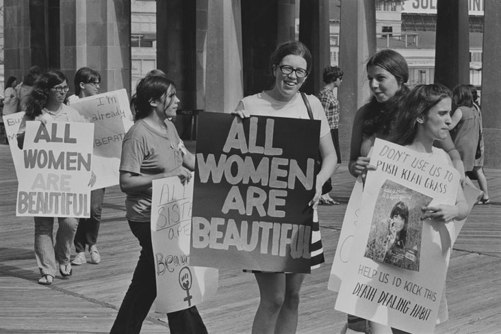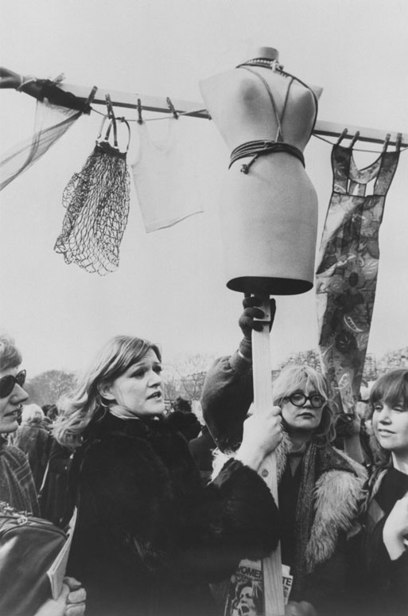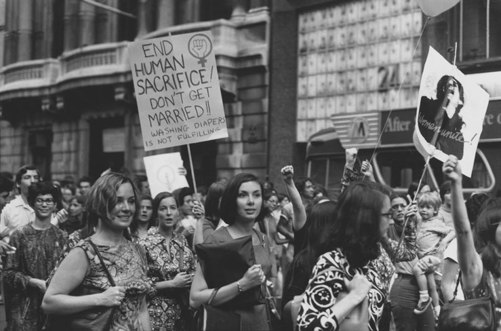Feminism (16 page)
Authors: Margaret Walters
Tags: #Social Science, #Feminism & Feminist Theory, #Anthropology, #Cultural, #History, #Social History, #Political Science, #Human Rights

In London, women had been meeting in small groups since 1969: some had been involved in protesting against the war in Vietnam, and helping American deserters; other women emerged from traditional left-wing groups, from student movements, or from the radically experimental Anti-University. Hackney women began producing a news-sheet called
Shrew
, and later issues were put out by other London groups. By the end of 1971,
Shrew
listed 56 groups
– plus one men’s group. A conference had been called in February 1970 in Oxford; so many women and children (and a few men) turned up that the venue was shifted from Ruskin College to the
minism
Oxford Union. Above all, the meetings offered women the
Fe
opportunity to talk: about loneliness, about equal rights at work, about childcare, about housework, about men, about revolution.
The emerging movement, rather optimistically perhaps, defined its demands: equal pay, equal education and opportunity, 24-hour nurseries, and free contraception and abortion on demand. A big march through London was organized, with banners announcing
‘we’re not beautiful, we’re not ugly, we’re angry’.
It remained a mainly middle-class movement, though there were many attempts to communicate with working-class women: feminists offered their support to a night cleaners’ campaign for better pay and conditions, and to a strike by women machinists at the Ford Dagenham plant.
Perhaps the most distinctive element in the new movement was its organization: women met in small groups, some locally based, others – later – formed to discuss particular issues, or work for 108

13. All women are beautiful: demonstration against the Miss America pageant, Atlantic City, 1969.
Body issues
One of the most urgent concerns of second-wave feminism
has been a woman’s rights over her own body. Western feminists have often addressed questions about beauty and the
value placed on a woman’s external appearance – an issue
which may seem, but only at first glance, superficial. Partly
driven by the tantalizingly glamorous media images that
swamp us, some seek refuge in an anxious, often ruinously
expensive, pursuit of the latest fashion. Others may turn to
more desperate and self-destructive measures: dieting to the
point of anorexia (which may alternate with compulsive eating and bulimia), or anxiously seeking the self-mutilation
that is cosmetic surgery.
Susie Orbach’s
Fat is a Feminist Issue
(1981) and Naomi
minism
Fe
Wolf ’s
The Beauty Myth
(1990) both explore the physical
self-hatred and the fear of ageing that, understandably,
plague so many contemporary women. And even in the affluent West, women have had to fight hard for the right to better health care: for adequate gynaecological advice and care
in childbirth; for the right to contraception and, if necessary,
abortion; and for more attention to those cancers, of the
breast and the womb, for example, that particularly affect
women.
particular causes. But most involved some kind of ‘consciousness-raising’. The term had been coined by an American, Kathie Sarachild: women would meet regularly and talk from their own experience. It was to have nothing to do with gossip; groups set out to explore both what women had in common and the issues that 110

14. Women’s Liberation groups marching through London, 1971.
111
divided them. The overall aim was to begin to understand private fears and discontents in a wider context, to discover, through
‘sharing, recognizing, naming’ their political implications. As Juliet Mitchell remarked, ‘women come into the movement from the unspecific frustration of their own private lives, find what they thought was an individual dilemma is a social predicament’.
Consciousness-raising, Mitchell has suggested, was a matter of
‘speaking the unspoken: the opposite, in fact, of ‘‘nattering together’’ ’. Women who cannot deal with the peculiar forms oppression takes in their private lives are ‘highly suspect when they begin to talk about forms of oppression that afflict other women . . .
If we cannot face our own problems we have no right to claim that we have answers to other people’s problems.’ Men were excluded, not, for the most part, out of hostility, but out of a recognition that women have the habit of deferring to men, ‘intellectually and/or flirtatiously’, at least in public.
minism
Consciousness-raising was never intended – as its detractors
Fe
sometimes claimed – merely as ‘group therapy’. At meetings, women would speak in turn about their problems and frustrations; not simply as an outlet for individual grievances, but, hopefully, as a step towards understanding that these may not simply be a result of their personal situations. It was to be a way of discovering what they had in common
as women
, whatever their differences of class or race or personal experience. (They were mostly, if not wholly, younger women, so differences of age were rarely addressed.) As one American feminist remarked, ‘consciousness-raising is a way of forming a political analysis on information we can trust is true.
That information is our experience.’ Another American, Shulamith Firestone, argued that ‘agitation for specific freedoms is worthless without the preliminary raising of consciousness necessary to utilize these freedoms in full’. Other women were less certain about it all. Some complained that consciousness-raising was particularly suited to the educated women of the middle and upper classes, and 112

15. As this banner suggests, the early movement, in America as in Britain, quickly learned to make its
arguments dramatically and wittily.
that these women were able to gain ascendancy over groups through their articulacy, their proficiency in this central activity. In fact, at the time, most women had little experience of group dynamics. Because the play of feelings within a group can be so unpredictable, even explosive, one or other member of a group might easily feel she was being unfairly criticized, made a scapegoat, or even excluded. Some meetings proved unexpectedly, and unhelpfully, painful. Sisterhood may be powerful; it was sometimes forgotten that the relationship between sisters may prove a troubled one. There were, inevitably, splits and disagreements. In England, one early conference was split – improbable as may sound – by a bitter quarrel between lesbian feminists and Maoist feminists. At another weekend conference, held in a building that was shared by a large group of coal miners, some women, who obviously had little clue about working-class men or about how to deflect their teasing aggression, began shouting that ‘sisters are being brutalized by the miners’.
minism
But (real) male violence was a problem that urgently needed to be
Fe
raised. Some feminists, particularly in America., disappointed by the failure to ensure passage of the Equal Rights Amendment and by threats to welfare and abortion rights, seized on this issue as a symbol of woman’s second-class status and her vulnerability. In 1975, the American Susan Brownmiller published a long, scholarly, and ground-breaking study of rape,
Against Our Will
, which deconstructed the centuries-old male ‘myth of the heroic rapist’, and coined a slogan that was rapidly picked up by other feminists:
‘pornography is the theory and rape the practice’. (One of those feminists was Susan Griffin, who made an effective attack on the easy and commonplace way people justify pornography, by claiming that is it ‘liberating’ for women as well as for men. In
Pornography
and Silence
(1981), she argued that, far from freeing erotic energy, as its defenders claimed, pornography expresses ‘fear of bodily knowledge and a desire to silence eros’.) Brownmiller went on to argue that rape is nothing more or less than a conscious process of intimidation used against
all
women by
all
men. She is not 114
sentimental about women; her later book,
Femininity
, deconstructs, disconcertingly and wittily, the games girls learn almost from the cradle: the tricks and techniques for charming men and competing with other women. Femininity, as we know it, is romantic nonsense, something that has to be carefully contrived and preserved. It is the product of ‘a nostalgic tradition of imposed limitation’. But
Against Our Will
mocks, bitterly and effectively, the way crimes of violence against women are so often dismissed with crude commonplaces: ‘No woman can be raped against her will’;
‘she was asking for it’; ‘if you’re going to be raped, you might as well relax and enjoy it’. She quotes, to telling effect, a (female) character in
Rabbit Redux
, a novel by the highly respected John Updike, who remarks dismissively, ‘You know what a rape usually is? It’s a
Secon
woman who changed her mind afterward.’
d-w
av
Unfortunately, this legitimate, urgently necessary insistence that
e feminism: th
rape is, indeed, a serious and violent crime, was distorted by some later feminists. For another American, Catherine McKinnon, woman is always, indeed almost by definition, a victim. ‘To be about
e lat
to be raped is to be gender female in the process of going about life
e 20th centur
as usual’, she insists.
You grow up with your father holding you down and covering your
y
mouth so another man can make a horrible searing pain between your legs. When you are older, your husband ties you to a bed and drips hot wax on your nipples and brings in other men to watch and makes you suck his penis . . . In this thousand years of silence, the camera is invented and pictures are made of you while these things are being done . . .
Her friend Andrea Dworkin argued that ‘pornography is the law for women’, and flatly, without any qualification, equated rape and sexual intercourse. As, indeed, did McKinnon, who from the opening paragraph of
Only Words
(1995) offers a terrible paradigm of what she sees as female experience: a primal paternal rape that freezes us in a state of permanent terror. She constantly evokes the 115
image of a once-violated child who can never grow up, who, she insists, lives on in most women, even those who claim to enjoy consensual sex: ‘the aggressor gets an erection; the victim screams and struggles and bleeds and blisters and becomes five years old’.
This is melodrama masquerading as feminism.
minism
Fe
116
‘Sisterhood is powerful’ was one of the most popular feminist slogans in the 1960s and 1970s. But the phrase has been questioned, and sometimes contested, both at the time, and ever since. As the black American poet Audre Lorde argued in 1983, it glosses over
difference of race, sexuality, class and age . . . Advocating the mere tolerance of difference between women is the grossest reformism. It is a total denial of the creative function of difference in our lives.
